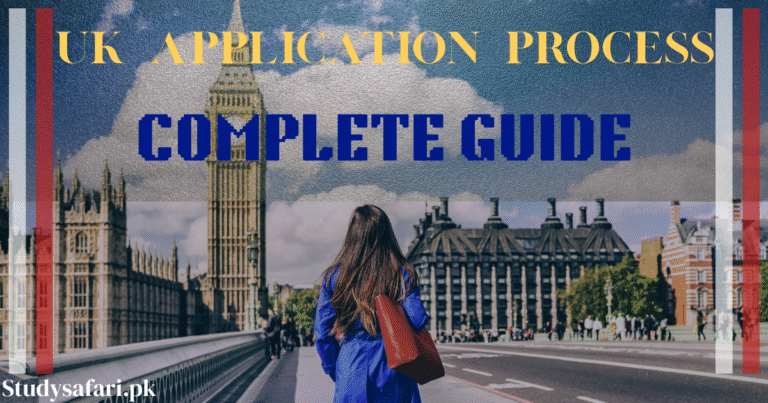Table of Contents
ToggleIntroduction:
Studying in the UK is a dream for many Pakistani students due to the country’s high-quality education, global degree recognition, and vibrant student life. However, to reach the UK as an international student, you must successfully go through the UK Student Visa (Tier 4/Student Route) process.
This comprehensive guide explains everything you need to know – from document checklists to bank statements, conditional offers, CAS, and visa application steps.

Steps:-
🎓 Step 1: choose the right Course & University
Before diving into visa requirements, the most critical step is selecting the right course and university. This decision lays the foundation for your entire academic and professional journey. Choosing the right course ensures that you’re investing time and money into a subject you’re passionate about and that aligns with your career goals. Meanwhile, selecting a reputable university – especially one recognized as a Licensed Student Sponsor by the UK Home Office (https://surl.lu/mgnpiq) is essential not only for visa approval but also for accessing quality education, resources, and future opportunities. A well-researched decision here can open doors to better job prospects, post-study work rights, and even permanent residency options down the line. That’s why this step should never be rushed – it’s the foundation of your UK study abroad journey.
✅ Step 2: Submit Your Documents
Once you’ve chosen the right course and university, the next step is to prepare and submit your documents. These usually include:
- Passport copy
- IELTS/TOEFL certificate (if available)
- All educational documents (transcripts and certificates)
- Work experience letters (to explain any study gaps)
- Detailed CV or Resume
- Statement of Purpose (SOP)
- Previous visa grant or refusal letter (if you have applied for any visa before)
- Two recommendation letters – should be on your university’s official letterhead and include your professors’ full names, positions, and contact details
Make sure all documents are clear, complete, and up to date to avoid delays in your application.
📩 After Submitting Your Application
Once you have submitted your application along with all the required documents, the next step is to wait for the university’s response. The university will review your application, verify your documents, and assess your eligibility for the course. This process may take a few days to a few weeks, depending on the university. Be patient during this time and keep an eye on your email for any updates or requests for additional information.
Finally, you will get an offer letter from the university. This can be either conditional or unconditional.
- A conditional offer means the university is willing to accept you, but you still need to provide some missing documents before your admission is confirmed.
- These missing documents could be:
- English language test results (like IELTS, PTE, or LanguageCert)
- Academic documents (like certificates or transcripts)
- Proof of fee payment (such as a deposit receipt)
Once you have submitted all the required documents and met the conditions, the university will issue your final or unconditional offer letter. This means your place is officially confirmed!
At this stage, it’s time to pay the initial deposit, which is the minimum fee required by the university to secure your admission.
🧾 Step 3: Ready for a CAS?
CAS stands for Confirmation of Acceptance for Studies. It is an official document issued by your UK university once you have received your unconditional offer and paid the initial deposit.
This unique CAS number is very important because:
- It confirms that the university has accepted you as a student.
- You need the CAS number to apply for your UK student visa.
- It includes important details about your course, start date, and your personal information.
Without the CAS, you cannot apply for a UK student visa, so make sure to keep it safe and use it carefully during your visa application process.
CAS Requirements Include:
- A bank statement showing at least 28 days of mature funds. This should cover your living expenses and tuition fees.
- For courses in London, you need to show £1,483 per month for up to 9 months.
- For courses outside London, you need to show £1,136 per month for up to 9 months.
- The remaining of tuition fee, which is usually between £6,000 and £8,000 after paying the initial deposit.
- A fee deposit slip or proof of payment for the initial deposit you paid to the university.
These documents prove that you have enough money to support yourself while studying in the UK, which is required to get your CAS and apply for your student visa.
Important Note:
👉 If You Are Using Your Parents’ Bank Account:
You will need to provide some additional documents to prove your relationship and get approval for using their financial support. First, submit your birth certificate to show the relationship between you and your parent(s). Then, provide a parental consent letter (affidavit of support), clearly stating that they are willing to support your education and living expenses in the UK. Both of these documents are required to meet the financial proof guidelines for your CAS and visa application.
🔔 Important Note About the 28-Day Bank Statement Rule
It is crucial to understand that the 28-day bank statement requirement means you must maintain the required amount continuously for 28 consecutive days in your bank account.
For example, if you are required to show proof of £20,000, your account must hold the equivalent amount in your local currency for the entire 28-day period – regardless of fluctuations in the exchange rate.
👉 If your balance drops even once during this period, the 28-day cycle will be invalidated, and you will need to restart the entire 28-day period from day one with the required full amount.
💡 Book Your TB Test
Students from Pakistan must undergo a tuberculosis test at a UK Home Office-approved clinic. This is a visa requirement.
🛂 Step 4: UK Visa Application
Once you have received your CAS (Confirmation of Acceptance for Studies), you can start your UK student visa application. To begin, visit the official UKVI website and fill out the online visa application form. You’ll need to upload or provide several important documents, including your passport, CAS letter, tuberculosis (TB) test certificate, bank statements (28 days mature), and educational documents.
After completing the form, you’ll need to pay the required visa fees. The student visa fee is £524 (one-time), and you’ll also need to pay the Immigration Health Surcharge (IHS), which is £776 per year. The IHS gives you access to the UK’s National Health Service (NHS), allowing you to receive healthcare during your stay.
Step 5: Final Steps – Biometrics to Travel
After submitting your visa application, the next step is to book a biometrics appointment at your nearest Visa Application Centre (VAC). During this appointment, you’ll be required to provide your fingerprints and photograph as part of the identity verification process.
Once your visa is approved, you will receive your passport with a 30-day vignette, which allows you to enter the UK within that time frame. After arriving in the UK, you must collect your Biometric Residence Permit (BRP) from the designated location mentioned in your visa letter. This BRP is your official visa document and proves your right to live, study, and work (if allowed) in the UK during your stay.





